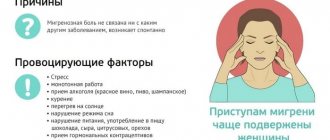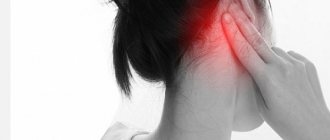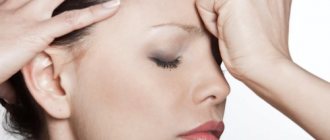Many people tend to endure pain, cope with discomfort with improvised means, take painkillers and limit themselves to complaints to loved ones that their temples are pressing and they are dizzy. This is often attributed to overwork due to heavy physical or mental labor, nervous tension and other reasons. At the same time, only a few go to doctors, and yet there can be quite a lot of causes for the occurrence of squeezing, aching or even acute pain in the temples in combination with dizziness, and not all of them are harmless.
Why does pain occur in the temples?
Physiological reasons
A dull pressing pain in the temples is observed when staying in a stuffy room. If a person cannot go out into the fresh air, the painful sensations increase, sometimes becoming sharp and pulsating. In some people, the symptom is triggered by strong feelings, most often anxiety and fear. May occur against the background of stressful situations. Another possible cause is starvation when trying to quickly lose weight, following strict diets, or eating disorders.
Migraine
The pain is pressing, throbbing, one-sided. The zone of maximum pain is located in the projection of the temple, eye or forehead. Sometimes an aura or prodrome is observed in the form of weakness, impaired ability to concentrate. It is typical for the affected side to change from one attack to another. Migraine symptoms are aggravated by bright light, loud sounds, and any physical activity. Patients try to “lie down” in solitude, silence and darkness.
Cluster headache
Pain occurs during periods of exacerbation, lasting from 2 weeks to 2 months. Appear suddenly, reaching a maximum after 1-3 minutes. The attack lasts from 15 minutes to 1 hour, less often up to 3 hours. Episodes occur at one time, often at night, and can be repeated from one per day to two to four (sometimes eight) during the day. Painful sensations are one-sided, more often on the left.
Localized in the eye, radiating to the temple, ear, cheek and teeth, extremely sharp, unbearable, stabbing or burning. Accompanied by nasal congestion, facial and conjunctival hyperemia. Described by patients as an “eye rupture” or “stabbed in the eye.” Photophobia, nausea and vomiting are observed in 30% of cases. The patient is agitated and rushes about, since physical activity somewhat reduces the intensity of the pain.
Tension headache
The symptom is mild or moderate. The headache is bilateral, non-pulsating, squeezing or squeezing the head with a “hoop”, especially noticeable in the temple area. There is no dependence on physical activity, no nausea or vomiting. The duration of the attack ranges from half an hour to 1 week. Pain increases with strong emotions and decreases with emotional relaxation.
Pain in temples
Primary and symptomatic hypertension
Along with essential hypertension, there are more than 50 diseases that cause high blood pressure. An increase in blood pressure, regardless of etiology, is accompanied by pain in the temples and back of the head. Patients complain of tinnitus, spots before the eyes, shortness of breath, chest pain, restlessness, or a feeling of fear. An external examination may reveal hyperemia of the skin. The symptom is observed in the following pathologies:
- Kidney diseases
: pyelonephritis, glomerulonephritis, hypoplasia, polycystic disease, amyloidosis, urolithiasis, tumors, diabetic nephropathy, renal tuberculosis. - Endocrine disorders
: pheochromocytoma, Cushing's disease and syndrome, primary aldosteronism. - Pathologies of large vessels
: coarctation of the aorta.
Hydrocephalus
Due to an increase in the amount of fluid in the cerebrospinal fluid system with hydrocephalus, intracranial pressure increases. Along with pain in the temples and throughout the head, intracranial hypertension is manifested by disturbances of consciousness, nausea, vomiting, blurred vision, and sometimes convulsive seizures. The symptom is detected in conditions such as:
- developmental defects: Chiari anomaly, Dandy-Walker syndrome, stenosis of the Sylvian aqueduct;
- intrauterine infections and birth injuries;
- traumatic brain injuries;
- inflammatory processes: encephalitis, meningitis, arachnoiditis;
- vascular pathologies: hemorrhagic stroke, intraventricular hemorrhage;
- neoplasms: colloid cysts, intracerebral ganglioneuromas, germinomas, astrocytomas, etc.
Traumatic brain injury
Headache is a constant symptom of TBI and is observed with injuries of any severity. Accompanied by dizziness, nausea, vomiting, amnesia. Impaired consciousness, paresis, decreased sensitivity, and other manifestations are possible. At first, the pain is usually diffuse. During the recovery period, pain in the temporal areas sometimes prevails.
Temporal arteritis
Caused by autoimmune damage to the temporal artery. Often occurs after viral infections. Horton's disease develops in middle-aged and elderly patients. Accompanied first by aching, then by piercing, burning pain in one or both temples, increasing over 2-3 weeks. The symptom worsens with chewing and talking. Complemented by loss of appetite, sweating, hyperthermia, weight loss, sleep disturbances, myalgia, arthralgia.
Intoxication syndrome
Pain in the temples is one of the possible variants of headache with intoxication syndrome against the background of bacterial and viral infections, local purulent processes. It can be dull, squeezing, aching, pulsating. Increased body temperature, weakness, weakness, dizziness, pain in joints and muscles are observed. Other signs are determined by the cause of intoxication.
Trigeminal neuralgia
Prosopalgia is paroxysmal in nature and is a series of intense, shooting, burning pain impulses that resemble an electric shock and spread from the lateral surface to the center of the face. The duration of the episode is up to two minutes, the attacks are repeated several times. When the nerve is completely involved, the entire half of the face suffers; when the second branch is affected, the pain is localized in the temple area, the outer corner of the eye, the adjacent part of the cheek, and the upper lip.
Damage to the temporomandibular joint
TMJ dysfunction is a problem that can be caused by the following factors:
- Dentofacial pathologies
: trauma, malocclusion, dental defects, poor-quality prosthetics, congenital anomalies. - Muscle overstrain
: bruxism, tonic spasm, overload of masticatory muscles, high speech load. - Psychological factors
: prolonged neuropsychic stress.
Typical symptoms include pain in the temples, eyes, ears, prosopalgia, headaches, difficulty and clicking when opening the mouth. Possible dizziness, sleep disorders, dysphagia, glossalgia, sleep apnea syndrome.
Other reasons
Sometimes hormonal changes become a provoking factor. Girls may experience pain in their temples during the onset of menstruation. Some mature women note the onset of symptoms during menopause. Another possible reason is intoxication. Pain in the temple area is observed in a state of alcoholic intoxication, with an overdose of certain medications, or carbon monoxide poisoning.
Can there be a noise in the head due to intracranial pressure?
Head noise and intracranial pressure are interrelated. With high ICP, the patient experiences discomfort from unpleasant buzzing, buzzing, hissing or ringing sounds. The intensity varies depending on the underlying disease.
Headache, noise in the head and ears are the main symptoms of high intracranial pressure. During the day, these symptoms may disappear on their own, reappear suddenly, or develop gradually, repeating over a long period of time.
Their feature:
- worsen in a horizontal position, so the clinical picture is most pronounced in the morning;
- bursting headache, pressing from the inside, not relieved by painkillers;
- pain spreads throughout the entire skull, most pronounced in the forehead, temples and back of the head.
Along with noise and pain in the head, the patient feels like something is pressing on the eyes, which causes vision to deteriorate and blurredness occurs. The pressure increases when the eyeballs move.
With ICP, cerebral vessels dilate, blood flow to the brain increases and its outflow decreases.
Other signs of the disease:
- nausea and vomiting (at the peak of the headache);
- dizziness;
- weather sensitivity;
- sleep disturbance;
- weakness, drowsiness;
- increased sweating;
- blood pressure surges;
- decreased performance;
- deterioration of memory, attention, intellectual abilities.
With high ICP levels, blood pressure increases, breathing is depressed and the pulse slows down, and the person loses consciousness. In severe cases, when vital structures of the brain are damaged, acute cerebrovascular accident occurs, convulsions, coma and death are likely.
Shpidonov Gennady Stanislavovich
Neurologist
Rostov State Medical University (neurology)
10 years of experience
Important! Impaired consciousness occurs when ICP increases to 30-40 mmHg. Art., coma – 40-50 mm Hg. Art., death – 50 mm Hg. Art. and higher.
We cannot wait for such serious complications. At the first signs of deterioration in health, you should consult a doctor.
Constant noise in the head is a common consequence of chronic cerebrovascular accident, against the background of which both arterial and intracranial hypertension can develop. Both conditions are life-threatening and can lead to stroke. Their diagnosis and treatment should be carried out by an experienced specialist.
Diagnostics
The diagnostic program is compiled by a neurologist. If necessary, a maxillofacial surgeon, infectious disease specialist, and other specialists are involved in the examination. To clarify the pathology, the following procedures may be prescribed:
- Questioning and external inspection
. During the conversation, the doctor finds out the time and circumstances of the onset of the symptom. Asks about the nature and duration of pain, other manifestations, as well as the presence of similar symptoms in blood relatives. Upon examination, increased blood pressure, skin hyperemia, renal edema, signs of endocrine pathology and infectious diseases may be detected. - Neurological examination
. With hydrocephalus, vestibular and cerebellar ataxia and nystagmus are possible. In patients with TBI, general cerebral and focal symptoms are determined. With trigeminal neuralgia, pain in trigger points is detected, with fascicular cephalgia - rhinorrhea, hyperhidrosis, drooping eyelid, conjunctival injection (during an attack). - Neuroimaging
. X-ray, CT, MRI, MRA and ultrasound techniques (duplex, Dopplerography) are informative for hydrocephalus, traumatic injuries, and determining the genesis of compression of the trigeminal nerve. They help to establish the cause of hydrocephalus and assess the severity of vascular damage in patients with arterial hypertension. - Lumbar puncture.
Indicated to clarify the cause of increased intracranial pressure, it is performed as part of an examination for traumatic brain injuries and neuroinfections. The resulting cerebrospinal fluid is sent for microscopic, microbiological, and PCR studies.
In addition, ultrasound of the kidneys and endocrine organs, radiography and computed tomography of the TMJ, laboratory tests to assess the condition of the body, determine the causative agents of common infections and purulent processes can be performed. For migraine, cluster cephalalgia, tension pain, additional studies are not very informative; differential diagnosis, carried out on the basis of clinical signs of the disease, comes to the fore.
Neurologist consultation
Treatment of headaches in the temples and forehead
Treatment for headaches at the Clinical Brain Institute is prescribed individually. The scheme will include steps aimed at eliminating both the root cause and symptoms of the disease:
- painkillers - help with mild headaches, can be found in any home medicine cabinet;
- antibiotic therapy is the main stage of treatment of inflammatory diseases of the eyes, brain, and inner ear;
- drugs to normalize blood pressure in case of hypotension or hypertension - they are often taken in a course to prevent acute attacks;
- additional techniques effective for diseases of the cervical spine: physiotherapy, exercise therapy;
- surgical intervention - is prescribed only in cases where conservative therapy is ineffective (for neoplasms, aneurysms, cataracts and other pathologies).
At home, it is important to follow all doctor’s recommendations and take prescribed medications on a precise schedule. In addition, it is necessary to follow the principles of proper nutrition and monitor your weight - this will help avoid chronic vascular diseases. For headaches, full sleep and a cold compress on the forehead and temples are recommended.
If you have a headache in the frontal region and temples, this can either be a sign of dangerous diseases or a consequence of ordinary fatigue. The Clinical Brain Institute specializes in the diagnosis and treatment of such disorders. The main advantages are modern equipment for examinations and analyses, high qualifications and many years of experience of specialists.
Treatment
Conservative therapy
The plan of conservative measures is determined by the etiology of the pain syndrome:
- Migraine
. To relieve attacks, simple and combined analgesics are used, and sometimes therapeutic blockades are performed. To prevent new paroxysms, antidepressants, anticonvulsants, and psychotropic drugs are used. - Tension headaches
. Medicinal methods include NSAIDs, antidepressants, muscle relaxants, occipital nerve blocks, non-medicinal methods - massage, manual therapy, acupuncture, biofeedback, relaxation techniques. - Bundle cephalalgia
. Paroxysms are eliminated with the help of triptans; in case of intolerance, oxygen inhalations are prescribed, and local anesthetics are injected into the nasal cavity. Calcium channel blockers are effective for preventive purposes. - Hydrocephalus
. In the case of an acquired variant of the pathology, the causative disease is treated and diuretics are prescribed. - Arterial hypertension
. Etiopathogenetic therapy is carried out. It is recommended to control blood pressure and take antihypertensive drugs. - Temporal arteritis
. The basis of drug therapy is glucocorticoid hormones. If there is no result, they switch to cytostatics. To eliminate symptoms, vasodilators, anticoagulants, and anti-inflammatory drugs are prescribed. - Trigeminal neuralgia
. Anticonvulsants are considered the first line treatment. Additionally, antispasmodics, microcirculation correctors, antihistamines, and therapeutic blockades are used. - TMJ dysfunction
. It may be necessary to eliminate dental pathologies. Soft food is recommended. Pain is reduced with the help of NSAIDs, antidepressants, botulinum therapy, glucocorticosteroid blockades, massage, and physiotherapy.
When should you consult a doctor?
Doctors at the Clinical Brain Institute recommend undergoing an examination if your headaches are too intense or occur frequently. If they go away on their own during the day, there is no cause for concern. However, some symptoms should promptly consult a doctor. These include:
- memory losses;
- exacerbation of reaction to light, auditory stimuli;
- impaired coordination of movements;
- increase in body temperature to critical levels;
- dizziness, fainting.
You can also take care of your own health at home. Regardless of age and type of activity, it is recommended to periodically measure blood pressure using a tonometer. Scheduled examinations are also a prerequisite. They include examination by a general practitioner, ophthalmologist, otolaryngologist, and electrocardiography.










